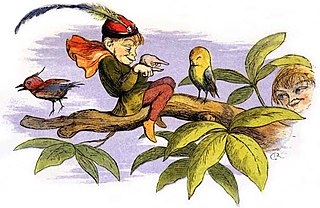Related Research Articles

Folklore is the body of culture shared by a particular group of people; it encompasses the traditions common to that culture, subculture or group. This includes oral traditions such as tales, legends, proverbs and jokes. They include material culture, ranging from traditional building styles to handmade toys common to the group. Folklore also includes customary lore, taking actions for folk beliefs, the forms and rituals of celebrations such as Christmas and weddings, folk dances and initiation rites. Each one of these, either singly or in combination, is considered a folklore artifact or traditional cultural expression. Just as essential as the form, folklore also encompasses the transmission of these artifacts from one region to another or from one generation to the next. Folklore is not something one can typically gain in a formal school curriculum or study in the fine arts. Instead, these traditions are passed along informally from one individual to another either through verbal instruction or demonstration. The academic study of folklore is called folklore studies or folkloristics, and it can be explored at undergraduate, graduate and Ph.D. levels.
A trow is a malignant or mischievous fairy or spirit in the folkloric traditions of the Orkney and Shetland islands. Trows may be regarded as monstrous giants at times, or quite the opposite, short-statured fairies dressed in grey.
A snipe hunt is a type of practical joke or fool's errand, in existence in North America as early as the 1840s, in which an unsuspecting newcomer is duped into trying to catch a nonexistent animal called a snipe. Although snipe are an actual family of birds, a snipe hunt is a quest for an imaginary creature whose description varies.

English folklore consists of the myths and legends of England, including the English region's mythical creatures, traditional recipes, urban legends, proverbs, superstitions, and folktales. Its cultural history is rooted in Celtic, Christian, and Germanic folklore.
Folk memory, also known as folklore or myths, refers to past events that have been passed orally from generation to generation. The events described by the memories may date back hundreds, thousands, or even tens of thousands of years and often have a local significance. They may explain physical features in the local environment, provide reasons for cultural traditions or give etymologies for the names of local places.

Folklore studies, also known as folkloristics, and occasionally tradition studies or folk life studies in the United Kingdom, is the branch of anthropology devoted to the study of folklore. This term, along with its synonyms, gained currency in the 1950s to distinguish the academic study of traditional culture from the folklore artifacts themselves. It became established as a field across both Europe and North America, coordinating with Volkskunde (German), folkeminner (Norwegian), and folkminnen (Swedish), among others.

Jan Harold Brunvand is a retired American folklorist, researcher, writer, public speaker, and professor emeritus of English at the University of Utah.

Irish folklore refers to the folktales, balladry, music, dance, and so forth, ultimately, all of folk culture.
Fakelore or pseudo-folklore is inauthentic, manufactured folklore presented as if it were genuinely traditional. The term can refer to new stories or songs made up, or to folklore that is reworked and modified for modern tastes. The element of misrepresentation is central; artists who draw on traditional stories in their work are not producing fakelore unless they claim that their creations are real folklore. Over the last several decades the term has generally fallen out of favor in folklore studies because it places an emphasis on origin instead of ongoing practice to determine authenticity.

Morris Edward Opler, American anthropologist and advocate of Japanese American civil rights, was born in Buffalo, New York. He was the brother of Marvin Opler, an anthropologist and social psychiatrist.

Gris-gris, is a Voodoo amulet originating in Africa which is believed to protect the wearer from evil or bring luck, and in some West African countries is used as a method of birth control. It consists of a small cloth bag, usually inscribed with verses from an African ancestor containing a ritual number of small objects, worn on the person.
Procession of the dead is a motif present in the folkloric traditions around the world. It mostly refers to a march of ghosts, phantoms or souls, sometimes commanded by a creature related to the Otherworld, the Underworld or the Afterlife. The concept is taken to be of considerable antiquity, and is classified in Stith Thompson's Motif-Index of Folk-Literature as Motif E491, "Procession of the dead".
Grateful dead is both a motif and a group of related folktales present in many cultures throughout the world.
A nuggle, njuggle, or neugle, is a mythical water horse of primarily Shetland folklore where it is also referred to as a shoepultie or shoopiltee on some parts of the islands. A nocturnal creature that is always of a male gender, there are occasional fleeting mentions of him connected with the Orkney islands but he is more frequently associated with the rivers, streams and lochs of Shetland. He is easily recognised by his distinctive wheel-like tail and, unlike his evil counterparts the each-uisge or the nuckelavee, has a fairly gentle disposition being more prone to playing pranks and making mischief rather than having malicious intents.
Joseph Médard Carrière (1902–1970), was an award-winning Franco-Ontarian French-language scholar. He was most noted as a collector of French folklore from the Midwest of the United States.

A dragonslayer is a person or being that slays dragons. Dragonslayers and the creatures they hunt have been popular in traditional stories from around the world: they are a type of story classified as type 300 in the Aarne–Thompson classification system. They continue to be popular in modern books, films, video games and other forms of entertainment. Dragonslayer-themed stories are also sometimes seen as having a chaoskampf theme - in which a heroic figure struggles against a monster that epitomises chaos.
Kenneth S. Goldstein was an American folklorist, educator and record producer and a "prime mover" in the American Folk Music Revival.

Kristin G. Congdon is an American artist, writer and a Professor Emerita of Philosophy and Humanities at the University of Central Florida. In her work she focuses on folk art, art education, art history, and feminism. She is the founding director of the Cultural Heritage Alliance at the University of Central Florida (UCF), which supports research into folk arts and folk arts education. She has written or contributed to over a dozen books on folk arts and is on the Editorial Board of the journal Artizein: Arts and Teaching Journal. She has toured with her art in Florida.
Urikohime, Uriko-hime or Uriko Hime is a Japanese folktale about a girl that is born out of a melon, adopted by a family and replaced by a creature named Amanojaku.

Hachikazuki or Hachi Katsugi is a Japanese folktale of the Otogi-zōshi genre. It refers to a maiden of noble birth who wears a bowl on her head and marries a prince.
References
- 1 2 3 Dorson, Richard M. (1954). "Negro Tales". Western Folklore. Western States Folklore Society. 13 (2/3): 160–169. doi:10.2307/1520611. JSTOR 1520611.
- ↑ Justus, James H (2004). Fetching the Old Southwest: Humorous Writing from Longstreet to Twain. University of Missouri Press. pp. 391–394. ISBN 9780826264176.
- ↑ Fauset, Arthur Huff (1927). "Negro Folk Tales from the South. (Alabama, Mississippi, Louisiana)". The Journal of American Folklore . American Folklore Society. 40 (157): 261. doi:10.2307/534988. JSTOR 534988.
- ↑ Ancelet, Barry Jean (1980). "Talking Pascal in Mamou: A Study in Folkloric Competence". Journal of the Folklore Institute. Indiana University Press. 17 (1): 1–24. doi:10.2307/3814219. JSTOR 3814219.
- ↑ Waymer, Jim (June 13, 2013). "'Giant' mosquito invasion? Nope, just another Florida critter". Florida Today. Melbourne, Florida: Gannett Co., Inc.